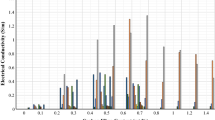Abstract
The approach to sustainability in architecture can be considered as the reduction of the use of resources during the whole life of buildings. For cement-based materials, the strategy is focused on material optimization related to raw materials extraction, manufacturing process, life span, and finally the possibility of reuse or recycling. This chapter shows the possibility of achieving the objective through novel and alternative ways where the environment-material interaction is the basis of this development for new cement-based materials. This adaptability results in materials with self-responsive properties: self-sensitive, self-healing, self-modulating, and self-cleaning. In the present paper, two self-responsive materials are shown. In the first case, material design is based on reducing energy consumption through energy efficiency, by accumulating heat in a dynamic environment. The second material investigates the self-sensitivity capacity that can diagnose and identify changes of mechanical properties that could compromise durability, saving maintenance resources.
In both studies, the search for new properties is achieved using different additions that incorporate new capabilities to the cement-based materials. Phase change materials (PCM) were used as self-modulating materials in cement-lime mortar for thermal regulation, while micro and nano carbon-based fibers (CNF) were used in self-compacting concrete (SCC) to vary the electrical properties, turning the material into a real-time sensor. These nano- and microscale modified materials are presented as real alternatives in the search for dynamic materials applied to sustainable construction.
Access this chapter
Tax calculation will be finalised at checkout
Purchases are for personal use only
Similar content being viewed by others
References
Alonso, M. C., & Puentes, J. (2020). Self-compacted concrete with self-protection and self-sensing functionality for energy infrastructures. Materials, 13(5), 1106.
Alonso, M. C., Puentes, J., Gómez, A., Chozas, V., & Vera, J. (2021). Health monitoring of failure detection of functionalized cementitious composites with self-diagnosis additives of CNT+CMF. In Proceedings of the international conference on SHMII-10 (Porto, Portugal), 251–258.
Azhari, F., & Banthia, N. (2012). Cement-based sensors with carbon fibers and carbon nanotube for piezo resistivity sensing. Cement and Concrete Composites, 34, 866–873.
Bekzhanova, Z., Memon, S. A., & Kim, J. R. (2021). Self-sensing cementitious composites: Review and perspective. Nanomaterials (Basel), 11(9), 2355.
Cabeza, L. F., Castell, A., Cabeza, L. F., De Gracia, A., & Fernandez, A. I. (2011). Materials used as PCM in thermal energy storage in buildings: A review. Renewable and Sustainable Energy Reviews, 15, 1675–1695.
Guardia, C., Barluenga, G., Palomar, I., & Diarce, G. (2019). Thermal enhanced cement- lime mortars with phase change materials (PCM), lightweight aggregate and cellulose fibers. Construction and Building Materials, 221, 586–594.
Guardia, C., Barluenga, G., & Palomar, I. (2020). PCM cement-lime mortars for enhanced energy efficiency of multilayered building enclosures under different climatic conditions. Materials, 13, 4043.
Han, B., Ding, S., & Yu, X. (2015). Intrinsic self-sensing concrete and structures: A review. Measurement, 59, 110–128.
Palomar, I., Barluenga, G., Ball, R. J., & Lawrence, M. (2019). Laboratory characterization of brick walls rendered with a pervious lime-cement mortar. Journal of Building Engineering, 23, 241–249.
Taheri, A. (2019). A review on five key sensors for monitoring of concrete structures. Construction and Building Materials, 204, 492–509.
Acknowledgments
The authors acknowledge the funds provided by the Research Program for the Promotion of Young Researchers, co-funded by Comunidad de Madrid and the University of Alcala (Spain), as part of the project IndoorComfort (CM/JIN/2019-46).
Also, this study has been partially funded by the European Union by the action HORIZON-TMA-MSCA-SE “BEST-Bio-based Energy-efficient materials and Structures for Tomorrow” (grant number 101086440).
Author information
Authors and Affiliations
Corresponding author
Editor information
Editors and Affiliations
Rights and permissions
Copyright information
© 2023 The Author(s), under exclusive license to Springer Nature Switzerland AG
About this chapter
Cite this chapter
Puentes, J., Palomar, I., Barluenga, G., Martin, C.G. (2023). Adaptative and Bioinspired Materials: Cement-Based Materials with Self-Modulating and Self-Sensing Properties. In: Cervera Sardá, M.R., Dușoiu, EC., Lascu, T.N. (eds) Architecture Inspired by Nature. Springer, Cham. https://doi.org/10.1007/978-3-031-33144-2_20
Download citation
DOI: https://doi.org/10.1007/978-3-031-33144-2_20
Published:
Publisher Name: Springer, Cham
Print ISBN: 978-3-031-33143-5
Online ISBN: 978-3-031-33144-2
eBook Packages: Literature, Cultural and Media StudiesLiterature, Cultural and Media Studies (R0)



